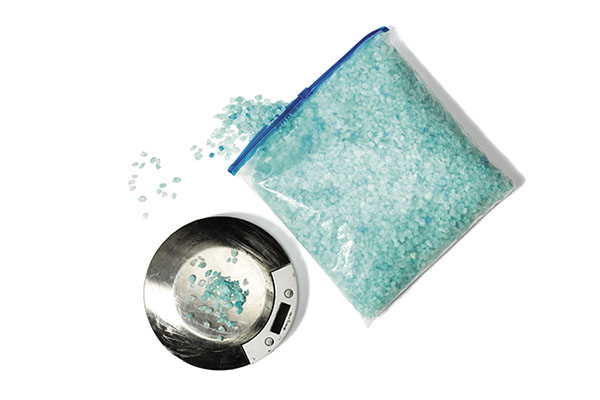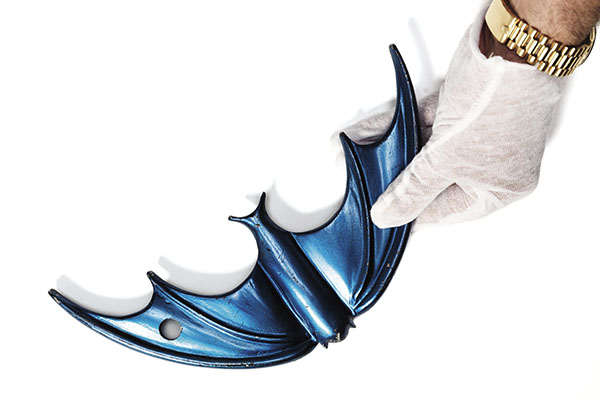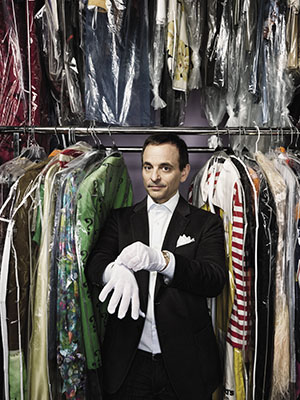
Comisar knows best about TV history
He can belly up to the original Cheers bar and owns a galaxy of Star Trek costumes. Now James Comisar wants to boldly go build a museum for his $100 million collection of TV memorabilia
A severed human head sits in a box on the floor of James Comisar’s office in Santa Monica, California. There is a bloody gash across the man’s neck, and the pale, goateed face stares back blankly as Comisar presents it, Hamlet-like. “This is the head of a biker from Sons of Anarchy,” he explains. “It ended up in a pot of chili in the episode. It’s a piece of art—it’s fantastic.”
He packs up the head and heads down the hall in his windowless warehouse. Past two sets of bulletproof doors, a table partly obscures a hallway. On it sits a 3-foot brass rail, half gleaming, half rusted. It’s a restoration in progress and an undeniable holy relic—part of the original Cheers bar. And the 50-year-old Comisar, a one-man Smithsonian of TV memorabilia, owns it. Over the past three decades, he has cultivated such a sufficiently expert reputation that CBS, which owned the rights, donated the bar to him in August 2014 in the hope he would restore the piece and publicly display it one day.
Comisar’s firm authority on all matters related to the small screen comes from 26 years of amassing more than 10,000 artifacts of television history. He possesses a nebbishy pedantry on the subject—stopping mid-conversation to spell out a Star Trek gadget as t-r-i-c-o-r-d-e-r, not triquarter—and dresses with the casualness of a sitcom extra.
Comisar grew up in Los Angeles wanting to become a comedy writer and earned a living for a few years writing jokes for performers like Joan Rivers. But as it happens in Hollywood, he found fame less attainable than illusory and so plowed his earnings into accumulating TV memorabilia. He has not only cornered the market (“There are few iconic TV pieces out there,” sighs an auction house president. “James has them all!”), he also sometimes sets it, given the strength of his collection.

Down the hall he arrives at what is, basically, a massive walk-in closet, perhaps 1,000 square feet of ceiling-to-floor racks of costumes, a dreamland for childhood dress-up. It contains some of Comisar’s most valuable pieces: Original Batman and Robin costumes from the 1960s TV series; George Reeves’ Adventures of Superman suit, which is little more than a heavy blue sweater; Ricky Ricardo’s blue-and-white polka-dot smoking jacket and straw boater.
Star Trek uniforms from the original series’ first season hang here, too, remarkably intact with the gold sleeve piping and starburst Star Fleet chest emblem. Most important, they’re made from the velour-like material that marks a Season 1 uniform. In later seasons, the designers switched to polyester, which helped hide some imperfections—namely, Comisar says, that the Enterprise’s captain had grown a little zaftig in space.
Money might be passé in the 23rd century, but in the early 21st, Comisar’s best Star Trek costumes are worth their weight in dilithium crystals—well, as much as half a million dollars by his estimate. “But I can squint into the future,” he says, “and see the pieces being worth $1 million.” As in $1 million each.

TV treasures: Walter White’s blue meth; Batman’s batarang
The market for pop culture memorabilia is booming, and Comisar has seen it coming for years. Last November, he sold a Golden Age Hollywood trophy—the original Cowardly Lion costume from The Wizard of Oz—for $3 million. The sale was worth it, since he had acquired the piece before deciding to focus on TV. One memorabilia rival notes that an item’s price increases if Comisar is the seller, a sign of respect for his devotion to authenticity and provenance. If Comisar sold smartly and slowly, art market experts estimate, his collection could bring as much as $100 million.
“These are cultural assets, but these are also my assets,” he says, explaining his true mission: To open a museum for his collection. His vision? A 30,000-square-foot space with more than a dozen rooms and exhibits tracing television back to its first flicker. The Cheers bar, as well as similar contributions from other TV deities, suggests that Hollywood trusts Comisar with its antiquities. But what he needs are benefactors and eight digits in donations.
Comisar makes some money consulting with celebrities eager to buy memorabilia or preserve items from their past roles. It’s enough to increase his acquisitions but not fund his dream. “All it takes is one guy to say, ‘Why shouldn’t these objects live on as long as the shows?’” he says. Making it harder, Comisar wants a bold-faced name to accompany the money. “I would love to work with someone like a Ryan Seacrest, who has such a personal connection with the TV audience.”
And he’s still very acquisitive. At a recent buying excursion to Julien’s, the posh Beverly Hills auction house, a clown’s outfit interested him. The garment—green zebra stripes and yellow ruffle at the collar—had belonged to Clarabell the Clown from The Howdy Doody Show. Comisar wound up passing on it because of its worn condition. He had spotted a red stain on the right shoulder. Maybe ketchup, maybe … blood? “If it was John Wayne, that’d be awesome,” he says, “but this is Clarabell the Clown.”
(This story appears in the 07 August, 2015 issue of Forbes India. To visit our Archives, click here.)















